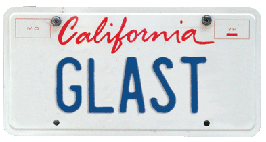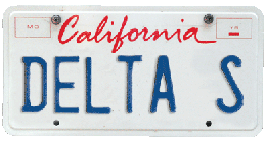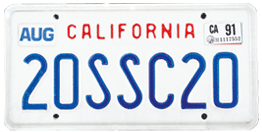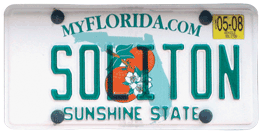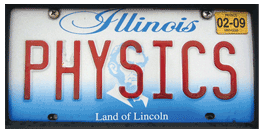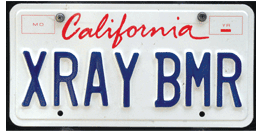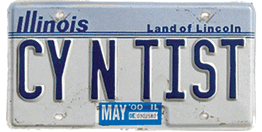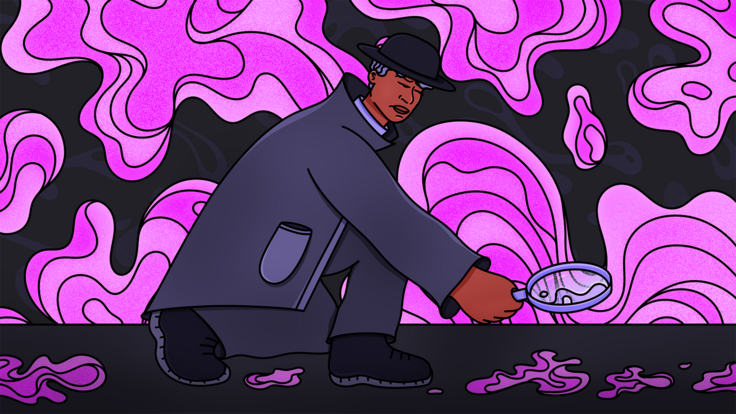A bumper crop of physics plates
In our October/November issue, we asked readers to share stories and photographs of physics-related license plates. Here are the responses.
by Matt Cunningham
These clever combinations of numbers, letters, and symbols are a mixed bag of inside jokes, conversation-starters, a way of recognizing likeminded people, and tangible reminders of the sweat, toil, and joys of research. They reflect not only their owners gusto for science, but also the desire, and need, to share it. Taken together, they present a much broader story than when viewed alone. They are the shorthand of proud scientists who wish to invite interaction. We hope you enjoy them as much as we did; please continue to send us your photos and stories.
|
Tune KamaeStanford Linear Accelerator Center Menlo Park, CaliforniaI acquired my plate from a visiting postdoc. He was fascinated to learn that one can customize license plates in the United States. I bought his car when he went back to Japan, mostly because of the GLAST (Gamma-ray Large Area Space Telescope) license plate. Later, I sold the car to another postdoc and kept the plate. Jonathan Ormes also had a GLAST plate when he was director of research at Goddard Space Flight Center in Maryland. Jonathan moved to Denver, so I dont know whats happened to it, but at one time there were an East Coast and West Coast GLAST. |
|
|
Jeff GeraciAnaheim, CaliforniaI had applied for this plate with the notion that I could get my life a bit more organized, provided there was a constant metaphorical reminder close at hand. The plate DELTA S is the term for the change in entropy, and was intended to be a reminder to keep up on maintenance, exercise, eat the right foods, keep organized files, de-fragment my hard drive, yada, yada, yada... My wife, Karen, agreed that this would be a noble gesture, and we did eventually bring some order to our nest. Nearly four years have passed since mounting that plate. Now we have a two-year-old son, Ronnie, who has done a fine job of restoring entropy in our household. Perhaps we can take some comfort in the fact that the term is variable. |
|
|
Chris QuiggFermilab Batavia, IllinoisBack in the days of the Superconducting Super Collider Central Design Group, my family presented me with license plates signifying the 20-TeV on 20-TeV collisions we planned for the SSC. It was a private source of pleasure for my colleagues and me. The world at large didn’t notice. It was on an ancient Volvo, which blended in with all of the other ancient Volvos in Berkeley. The plate hangs in my garage now. It’s a memento from one of the most intense times I’ve been through. It’s a treasure from that great time. |
|
|
L.N. BlancoMiami, FloridaI’ve had the custom license plate SOLITON for 30 years. I transfer it from one car to the next. In many ways a car behaves like a soliton: It is a wave localized in a certain region of space, it keeps its shape when traveling, and it interacts with other solitons (cars) emerging unchanged, most times, perhaps with only a small phase shift. About 28 years ago, I was attending a conference at a hotel in Fort Lauderdale. During the meeting, an employee interrupted to find the owner of a car parked in a restricted spot. The employee spelled the tag S-O-L-I-T-O-N and then pronounced it. I stood up to tell the employee that I was the owner, right as a physicist in the audience said something like, "A soliton at rest, parked outside? Don’t worry, it will probably collapse and disappear rapidly." Everyone burst into laughter. As we walked toward the parking lot, I tried to explain the meaning of the word soliton to the puzzled employee. |
|
|
Jamie SantucciFermilab Batavia, IllinoisI have Illinois license plate PHYSICS on my 2005 Toyota Camry. I believe that it cannot get more physics than that! The story is simple, unlike Tom Nash’s (Oct/Nov 07). I work at Fermilab and I used to have a Toyota pickup truck with 900 GEV plates (the TeV ring energy at that time). When I traded my truck in for a Camry, I had to get new plates because Illinois does not allow truck plates on cars. I applied for PHYSICS as my first choice and, much to my surprise, I got it. |
|
|
Steve AxelrodLos Altos, CaliforniaMy license plate was originally suggested a year ago by my two young daughters. The plate, XRAY BMR, is on a BMW 330 convertible. It applies to both the car and me, since I’m helping to develop a new miniature X-ray tube to treat breast cancer. My colleagues think it’s cute, but I haven’t got many questions outside of work. Maybe people are scared that the car emits X-rays. |
|
|
Richard JanesBellevue, IowaWhen I visited my hometown in Wisconsin, relatives and friends kept calling me “the scientist” because I worked at Argonne National Lab and later Fermilab. I responded, in time, with this vanity plate. |
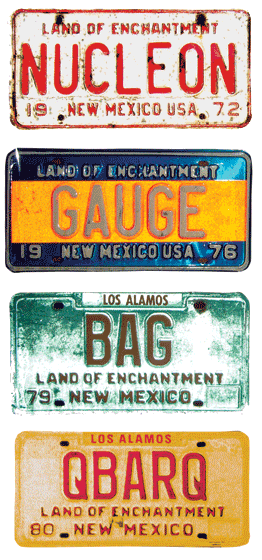 |
Leon Heller
Los Alamos National Laboratory
Los Alamos, New Mexico
Its a lot of fun and a great conversation starter using aspects of my work as a physicist on license plates. Friends are quick to spot whenever a new one goes on the car, and invariably ask what it means. For some I provide a brief explanation, but for my weekly hiking group there is ample time to also give some background about the significance of the research. Those not familiar with Los Alamos National Laboratory are pleasantly surprised to learn that there is basic research going on in addition to work on nuclear weapons.
I try to come up with a new license plate every year. I am proudest of the very first one: NUCLEON, because it contains my first name. On the other hand, one wag suggested it was an invitation to nuke Leon.
The operation of a high intensity proton linear accelerator at Los Alamos yielded large fluxes of pi mesons and led to PION. The advent of the quark revolution and development of a gauge theory based on the color degree of freedom, involving different flavors of quarks interacting with glue, led to a long research period and many license plates: COLOUR, FLAVOUR (British spellings), GAUGE, UP, DOWN, and GLUE. At MIT a bag model of the interaction of quarks and glue was developed, and led to BAG.
QBARQ represents a meson made of a quark and anti-quark. DIMESON signifies a particle composed of two quarks and two anti-quarks. OMEGA-* is a particle comprised of three strange quarks. (An excited state is normally denoted with an asterisk, which is not available in New Mexico, but the Zia symbol is close enough.)
I have about 30 plates in my basement. Ive kept every one, with one exception. A local restaurateur, who is also a scientist at the laboratory, recently decided to turn a portion of his restaurant into a bar, which is a place for people to meet and talk science. He named the bar Quark. I told him I had a plate by the same name and let him borrow it.
A strange thing happened involving that plate back in 1975. I was driving home, and in my rear view mirror I noticed the car behind me was uncomfortably close. I could easily make out the QUARKS California plate on the front of the car. I had no doubt that the car belonged to Murray Gell-Mann, who had earlier proposed such fractionally charged particles and gave them the name that stuck. He was visiting Los Alamos that summer, but was not in the car at the time; I think his wife was behind the wheel. I was concerned about a possible collision of quarks, but fortunately no accident occurred.
e+e
Ben Smith and Jym Clendenin
Stanford Linear Accelerator Center
Menlo Park, California
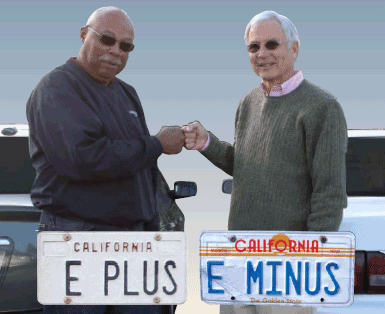 |
| Photo: Diana Rogers, SLAC |
Ben and Jym offer similar explanations when asked about the meaning of their plates. It goes something like this: It stands for positron (electron), which is the antiparticle for the electron (positron), both of which are accelerated by the two-mile-long SLAC linac where I work. Generally, upon hearing the word antiparticle the questioners eyes are seen to glaze over and the conversation either ends or goes on to another subject.
SLACers, on the other hand, usually say something like: Be sure not to run into E MINUS (E PLUS) or youll be annihilated!
Both Ben and Jym plan to keep their plates for the indefinite future.
E PLUS
Ben Smith, a retired SLAC engineer, acquired his plates about 15 years ago when he was designing and installing the Stanford Linear Collider positron source.
Common question
Does that stand for educational excellence?
E MINUS
Jym Clendenin, a retired SLAC physicist, also acquired his plates about 15 years ago when he was commissioning the SLC polarized electron source. He was in charge of the SLAC linac electron injector until his recent retirement.
Common question
Thats a really poor grade!
Click here to download the pdf version of this article.



